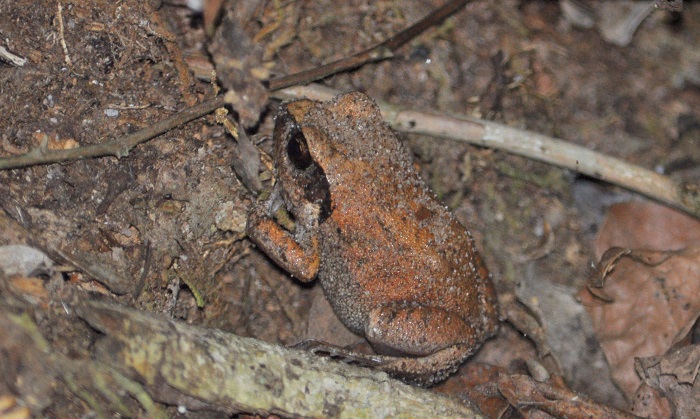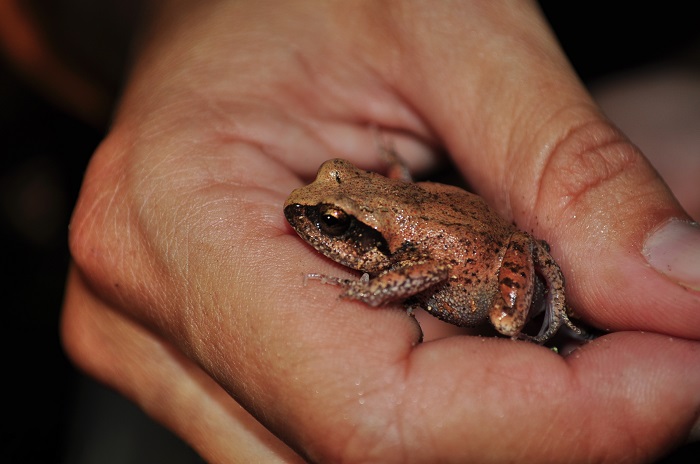Cover photo by Len de Beer.
Find the Shovel-footed Squeaker in the FBIS database (Freshwater Biodiversity Information System) here.
Family Arthroleptidae
Identification
The Shovel-footed Squeaker is a stocky species with a broad, stubby head. It attains a maximum size of 45mm and is larger than others in the genus. The skin above varies from light to dark brown. A dark 3-lobed hourglass pattern is often present on the back. A thin, pale vertebral stripe is sometimes also visible. The Shovel-footed Squeaker has a dark facial mask extending from the tip of the snout, through the eye, to the base of the forearm. The undersides are granular and typically white with grey flecks in the chest region.

Bhanga Nek, iSimangaliso Wetland Park, KwaZulu-Natal
Photo by Ryan Tippett
Habitat
In South Africa, the Shovel-footed Squeaker occurs in wooded areas with abundant leaf litter and sandy soils. Along the coast, it inhabits dune Forest and forest patches in Coastal Bushveld/Grassland. In the northern Kruger National Park, it was found in the leaf litter of riverine woodland (H.H. Braack pers. comm.). Breeding takes place in the same habitat.

Photo by Ryan Tippett
Behaviour
The Shovel-footed Squeaker breeds from December to February (Stewart 1967). Males call from the ground among leaf litter. The eggs are laid in hollows or shallow burrows in leaf litter beneath bushes or around the roots of trees. Up to 80 eggs are laid, which develop directly into small froglets (Barbour and Loveridge 1928; Loveridge 1953a).

Kosi Bay, KwaZulu-Natal
Photo by Tyrone Ping
During the dry season, the adults take shelter in hollow trees, moss, rotten wood, and soil at the base of trees (Loveridge 1953b,c).
The diet of the Shovel-footed Squeaker includes termites, ants, and a wide range of other small arthropods. More unusual items include snails and frogs (Barbour and Loveridge 1928; Inger and Marx 1961). The Shovel-footed Squeaker is fed upon by various snakes, including Eastern Vine Snake Thelotornis mossambicanus, White-lipped Snake Crotaphopeltis tornieri, Eastern Stripe-bellied Sand Snake Psammophis orientalis, and Green Water Snake Philothamnus hoplogaster (Barbour and Loveridge 1928; Loveridge 1953a; Blake 1965).

Zimbabwe
Photo by Nick Hart
Status and Conservation
The Shovel-footed Squeaker is common and does not require specific conservation action.
Distribution

A. stenodactylus is a widespread species that extends from southern and eastern DRC to Kenya, south to Zimbabwe and Mozambique. In the atlas region it has a peripheral distribution, occurring along the coastal plain north of Empangeni (2831DD), and in the Limpopo River valley in the extreme north of Limpopo Province. This species is easily recognized by its call. The atlas data are reliable.

Bhanga Nek, iSimangaliso Wetland Park, KwaZulu-Natal
Photo by Ryan Tippett
Further Resources
The use of photographs by Len de Beer, Nick Hart, and Tyrone Ping is acknowledged. Other photographs by Ryan Tippett.
Shovel-footed Squeaker Arthroleptis stenodactylus Pfeffer, 1893
Other Common Names: Dune Squeaker, Common Squeaker (Alt. English); Graafpootkikker (Afrikaans).
Recommended citation format: Channing, A; Tippett, RM. (2025). Shovel-footed Squeaker Arthroleptis stenodactylus. Biodiversity and Development Institute, Cape Town. Available online at https://thebdi.org/2022/01/10/shovel-footed-squeaker-arthroleptis-stenodactylus/
This species text has been updated and expanded from the text in the
2004 frog atlas: Channing, A. (2004). Shovel-footed Squeaker Arthroleptis stenodactylus. In Minter LR
et al 2004.
References:
Minter, LR; Burger, M; Harrison, JA; Braack, HH; Bishop, PJ; Kloepfer, D. (Editors). (2004). Atlas and Red Data Book of the Frogs of South Africa, Lesotho and Swaziland. Smithsonian Institution, Washington, and Avian Demography
Unit, Cape Town.
Carruthers, V; du Preez, L. (2017). Frogs of southern Africa: A Complete Guide. Struik Nature, Cape Town.
Channing, A. (2001) Amphibians of Central and Southern Africa. Protea Book House, Pretoria
Claus, B; Claus, R. (2002). Common Amphibians and Reptiles of Botswana. Gamsberg Macmillan, Windhoek.

